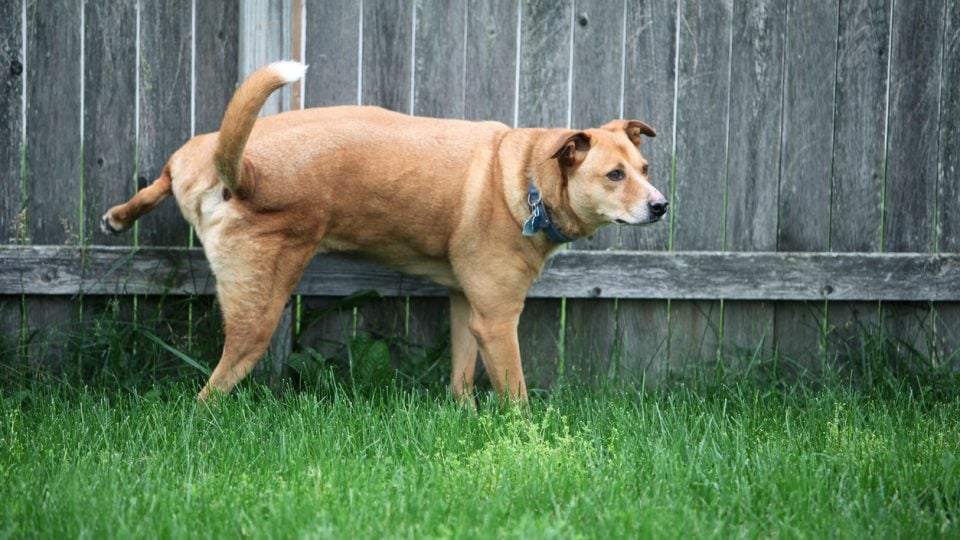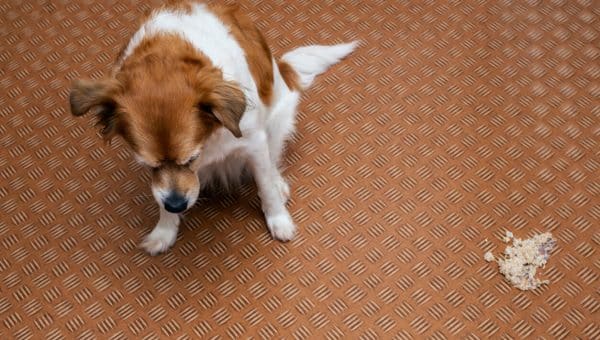- Not a substitute for professional veterinary help.
Have you ever suspected that your dog pees too much? If so, have you ever wondered how many times a day your dog should be peeing?
There can be a wide range of normal, and some dog trainers and veterinarians report that smaller dogs pee more often than larger dogs. Puppies definitely urinate more frequently, too. That said, going every four to eight hours is common for your average dog.
Understanding Your Dog’s Routines
Should you worry about your dog’s potty habits?
Start by paying closer attention. Jot down the information to track every time your dog pees in a day (and where). This will provide you with a baseline for your dog’s usual potty schedule and needs.
Assess your dog’s behaviors, too. Is she whining and crying at the door to go out? Is she marking tiny drops, or releasing full puddles?
Monitoring your dog’s fluid intake will also provide you with clues. Is she drinking more water? Is it because the temperature is extra hot outside?
Excessive Peeing: Medical Issues
These warning signs indicate illness or infection in your dog:
- Straining to pee
- Unusual odor
- Excessive drinking
- Blood in the urine
Blood, or even a dark orange to red color, might show a urinary tract infection. Whether or not you see blood in her urine, if you get a sense that your dog is straining or uncomfortable, if her behavior seems different, your local veterinarian should be your first stop.
According to Studio Animal Hospital vet Dr. Mike McClenahan, “Bladder infections, stones, or inflammation, for example, can be extremely painful for your pet and will require medical care. No fun letting your dog suffer and driving yourself mad with accidents she wouldn’t be able to help if a health issue is occurring.”
Getting a full examination performed on your dog, including taking a urine sample to be cultured, may rule out bladder or urinary tract complications. Find out what’s going on; it’s better to be safe than sorry.
If it seems abnormal, they might require alternative tests at your vet’s office, such as taking bloodwork or doing X-Rays to make sure a disease like Cushing’s isn’t at play.
Cushing’s disease occurs when a dog’s body produces too much cortisol hormone, which in turn gets stored in the adrenals above the kidneys.
Another illness to test for is the possibility of diabetes, which happens when a dog’s pancreas stops making sufficient insulin. This hormone is necessary to regulate glucose and without appropriate amounts, blood sugar levels soar.
When Dogs Pee Too Much: Behavior Reasons
Hopefully, your dog’s results all come back healthy. Great! But then what? Keep in mind the things that affect your dog’s need to pee:
- Diet
- Water intake
- Exercise and activity level
- Temperature
- Age and medical history
- When they last peed
- Their level of potty training
Seniors and Puppies
Many dog owners work outside of the home for eight or more hours a day and find that booking a dog walker to give their pet a break is a solution. Perhaps your dog needs more exercise, another opportunity to relieve herself of water she’s been drinking, or even more stimulation.
As mentioned above, this especially true if you’ve recently adopted a puppy! Be prepared to let your puppy out much more often, sometimes every hour, and pay close attention to her when she wakes from a nap or finishes eating and drinking. Potty training is a process that requires your vigilance, consistency, and patience.
On the other side of the spectrum, older dogs, particularly those on medications, sometimes need to outside more frequently as well. Medicines might affect their systems. Incontinence is also a possibility for senior dogs. A veterinarian can help you diagnose your dog and determine if treatment options are viable. Some older dogs end up wearing diapers to curb the issue.
Diet and Marking
What your dog eats should be taken into account. Wet food has more moisture than kibble, and canned food containing salt will lead to more peeing and thirst. Dogs don’t sweat like we do, they pant!
That system of regulating heat might cause them to lose more stored water in their body, therefore to drink more water, and therefore to pee more, too.
Marking is a behavior more common for unneutered or unspayed animals, as it is a natural instinct to mark territory and attract a mate. It can affect fixed animals too, although usually spaying and neutering reduce or eliminate the desire to mark, on top of preventing unwanted litters.
It’s significant to note that dogs not only eliminate but also communicate by peeing. When and where they go can carry information about their interests, their mood, and any messages they wish to leave behind. Peeing is a huge part of her life!
Experts at WebMD refer to “social triggers,” such as anxiety or something new in the environment causing your dog to need to mark and message.
Next Steps
Make sure you properly clean any accidents that happen around your house. The last thing you want is to encourage more accidents because of a lingering scent of pee, urging your dog to make there again!
If you need further support, whether it’s to house-train a puppy or an older rescue dog, look no further than here and here.
It can seem like just another chore, but how and when and where your dog goes to the bathroom offers you a ton of information on top of a chance to know your dog even better. Pay attention. And be there to praise her when she does it right.





